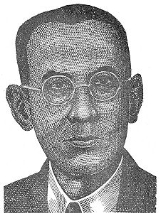
Julián Felipe
Encyclopedia
Julián Felipe was the composer of the music of the Filipino national anthem, now known as Lupang Hinirang.
julian felipe
He was born in Cavite City
, Cavite
. A dedicated music teacher and composer, he was appointed by then-President Emilio Aguinaldo
as Director of the National Band of the First Philippine Republic
. He died in Manila
.
He studied at a public school in Cavite and Binondo, Manila for his primary education. At an early age, he showed his talent in music. He also learned how to play the piano and the organ. Later, He became an organist in St. Peter's Parish Church. As an organist, Felipe was given the chance to hone his gift. Soon after he was composing songs.
Among his early popular compositions were Moteti el Santesisimo, Sintos y Floras Rogodones, Amorita Danza and Reina de Cavite (In honor of Nuestra Señora dela Soledad de Porta Vaga). He impressed many music enthusiasts with the said pieces. Though still young, his works were already at par with the seasoned musicians.
In recognition of his remarkable contributions in the field of music, he was given awards and accolades.
When freed, he again joined Gen. Emilio Aguinaldo's troop. He composed nationalistic songs that inspired his compatriots to continue fighting against the Spaniards.
A bust
of Felipe can be found in Cavite City, located near San Sebastian College – Recoletos de Cavite.
julian felipe
He was born in Cavite City
Cavite City
The City of Cavite is a fourth class city in the province of Cavite, Philippines. The city occupies a hook shaped peninsula jutting out into Manila Bay. Cavite City used to be the capital of the province...
, Cavite
Cavite
Cavite is a province of the Philippines located on the southern shores of Manila Bay in the CALABARZON region in Luzon, just 30 kilometers south of Manila. Cavite is surrounded by Laguna to the east, Metro Manila to the northeast, and Batangas to the south...
. A dedicated music teacher and composer, he was appointed by then-President Emilio Aguinaldo
Emilio Aguinaldo
Emilio Aguinaldo y Famy was a Filipino general, politician, and independence leader. He played an instrumental role during the Philippines' revolution against Spain, and the subsequent Philippine-American War or War of Philippine Independence that resisted American occupation...
as Director of the National Band of the First Philippine Republic
First Philippine Republic
The Philippine Republic , more commonly known as the First Philippine Republic or the Malolos Republic was a short-lived insurgent revolutionary government in the Philippines...
. He died in Manila
Manila
Manila is the capital of the Philippines. It is one of the sixteen cities forming Metro Manila.Manila is located on the eastern shores of Manila Bay and is bordered by Navotas and Caloocan to the north, Quezon City to the northeast, San Juan and Mandaluyong to the east, Makati on the southeast,...
.
He studied at a public school in Cavite and Binondo, Manila for his primary education. At an early age, he showed his talent in music. He also learned how to play the piano and the organ. Later, He became an organist in St. Peter's Parish Church. As an organist, Felipe was given the chance to hone his gift. Soon after he was composing songs.
Among his early popular compositions were Moteti el Santesisimo, Sintos y Floras Rogodones, Amorita Danza and Reina de Cavite (In honor of Nuestra Señora dela Soledad de Porta Vaga). He impressed many music enthusiasts with the said pieces. Though still young, his works were already at par with the seasoned musicians.
In recognition of his remarkable contributions in the field of music, he was given awards and accolades.
Philippine Revolution
When the revolution broke out, Julian joined his fellow Cavitenos who fought against the Spaniards. He was arrested and jailed at Fort San Felipe in Cavite.When freed, he again joined Gen. Emilio Aguinaldo's troop. He composed nationalistic songs that inspired his compatriots to continue fighting against the Spaniards.
A bust
Bust (sculpture)
A bust is a sculpted or cast representation of the upper part of the human figure, depicting a person's head and neck, as well as a variable portion of the chest and shoulders. The piece is normally supported by a plinth. These forms recreate the likeness of an individual...
of Felipe can be found in Cavite City, located near San Sebastian College – Recoletos de Cavite.
National Anthem
Gen. Aguinaldo asked him to provide a stirring composition to be played in the historic proclamation of Philippine independence. His composition Marcha Nacional Filipina, played on June 12, 1898 in Aguinaldo's home in Kawit, was adopted as the Philippine national anthem on September 5, 1938.Personal Life
Julian and his wife Irene Tapia had four daughters and a son. Julian died on October 2, 1944, at age of 83.External links
- Historia de la Marcha Nacional Filipino Full text document written by Julián Felipe on the history of the Philippine National Anthem.

